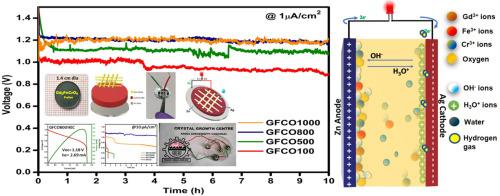Enhanced Energy Harvesting of Novel Gd₂FeCrO₆ Double Perovskite Hydroelectric Cells with Sustained Voltage Discharge
IF 5.7
3区 材料科学
Q2 MATERIALS SCIENCE, MULTIDISCIPLINARY
引用次数: 0
Abstract
In the pursuit of sustainable energy generation and on-demand energy production, hydroelectric cell (HEC) is claimed to be a breakthrough renewable energy technology for harnessing the electrical energy via water splitting at ambient conditions. This study presents the pioneering Gd₂FeCrO₆ (GFCO) double perovskite HEC, synthesized via sol-gel auto-combustion, exhibiting a sevenfold output increase over non-perovskite HECs. Comprehensive characterization using XRD, TEM, FESEM, FTIR, BET-BJH, and XPS confirmed its crystallinity, morphology, functional groups, porosity, chemical states, and oxygen vacancies. Key performance metrics in the GFCO800 HEC (1.5 cm²), demonstrated a remarkable open-circuit voltage (1.18 V), peak current (2.69 mA), and achieved breakthrough sustained discharge stability over 10 h at 10 µA/cm². Four series-connected GFCO800 HEC powered a red LED for 20 minutes under outdoor conditions. These results highlight the GFCO HECs as carbon-neutral energy harvesting devices capable of hydrogen evolution and low-power operation, indicating their potential for portable and next-generation sustainable energy applications.

新型持续电压放电Gd₂FeCrO₆双钙钛矿水力电池的强化能量收集
在追求可持续能源生产和按需能源生产的过程中,水力电池(HEC)被认为是一项突破性的可再生能源技术,它可以在环境条件下通过水分解来利用电能。本研究提出了采用溶胶-凝胶自燃法合成的Gd₂FeCrO (GFCO)双钙钛矿型货轮货轮,其产量比非钙钛矿型货轮货轮产量提高了7倍。通过XRD、TEM、FESEM、FTIR、BET-BJH和XPS等综合表征,证实了其结晶度、形貌、官能团、孔隙度、化学状态和氧空位。GFCO800 HEC (1.5 cm²)的关键性能指标显示出显著的开路电压(1.18 V),峰值电流(2.69 mA),并在10 μ a /cm²下实现了超过10小时的突破性持续放电稳定性。四个串联的GFCO800 HEC在室外条件下为红色LED供电20分钟。这些结果突出了GFCO HECs作为碳中和能源收集设备,能够析氢和低功耗运行,表明其在便携式和下一代可持续能源应用方面的潜力。
本文章由计算机程序翻译,如有差异,请以英文原文为准。
求助全文
约1分钟内获得全文
求助全文
来源期刊

Materials Research Bulletin
工程技术-材料科学:综合
CiteScore
9.80
自引率
5.60%
发文量
372
审稿时长
42 days
期刊介绍:
Materials Research Bulletin is an international journal reporting high-impact research on processing-structure-property relationships in functional materials and nanomaterials with interesting electronic, magnetic, optical, thermal, mechanical or catalytic properties. Papers purely on thermodynamics or theoretical calculations (e.g., density functional theory) do not fall within the scope of the journal unless they also demonstrate a clear link to physical properties. Topics covered include functional materials (e.g., dielectrics, pyroelectrics, piezoelectrics, ferroelectrics, relaxors, thermoelectrics, etc.); electrochemistry and solid-state ionics (e.g., photovoltaics, batteries, sensors, and fuel cells); nanomaterials, graphene, and nanocomposites; luminescence and photocatalysis; crystal-structure and defect-structure analysis; novel electronics; non-crystalline solids; flexible electronics; protein-material interactions; and polymeric ion-exchange membranes.
 求助内容:
求助内容: 应助结果提醒方式:
应助结果提醒方式:


